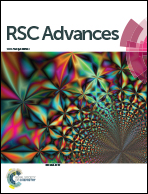Size, vacancy and temperature effects on Young’s modulus of silicene nanoribbons†
Abstract
We report results on the Young’s modulus (YM) of defect-free and defective silicene nanoribbons (SNRs) as a function of length and temperature. In this study, we perform molecular dynamics simulations using the Environment-Dependent Interatomic Potential (EDIP) to describe the interaction of the Si atoms. We find that the YM of pristine and defective SNRs increases with the ribbon length in both chirality directions. It is shown that the YM of defective SNRs exhibits a complex dependence on the combinations of vacancies. With respect to temperature, we find that YM for SNRs with and without vacancy defects shows nonlinear behavior and it could be tailored for a given length and chirality.


 Please wait while we load your content...
Please wait while we load your content...